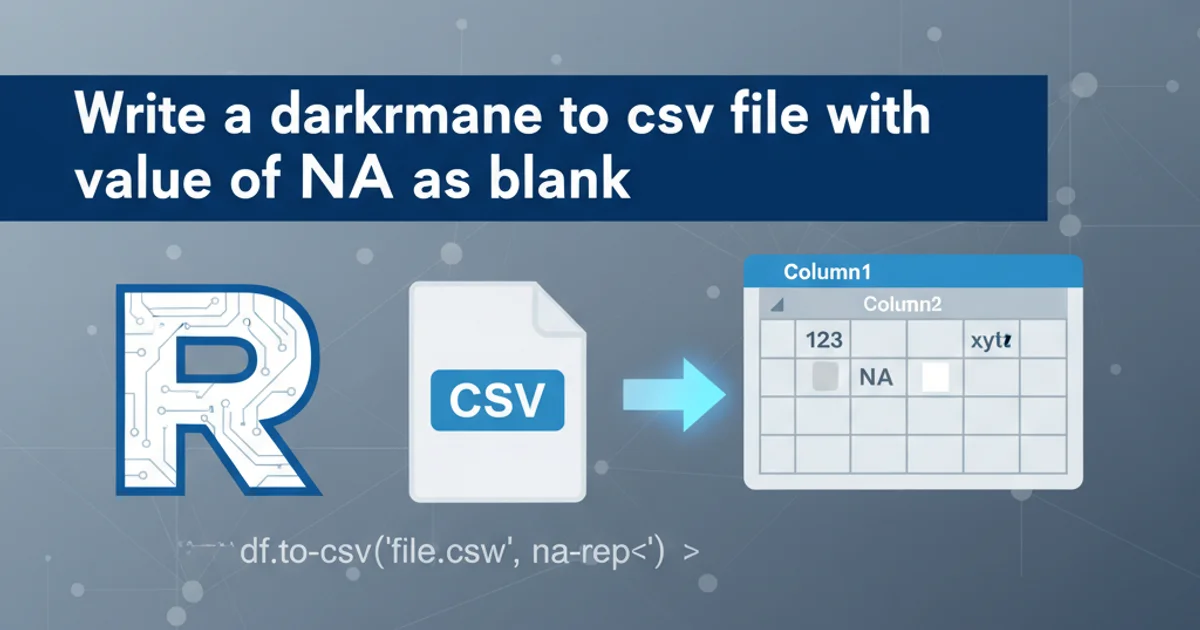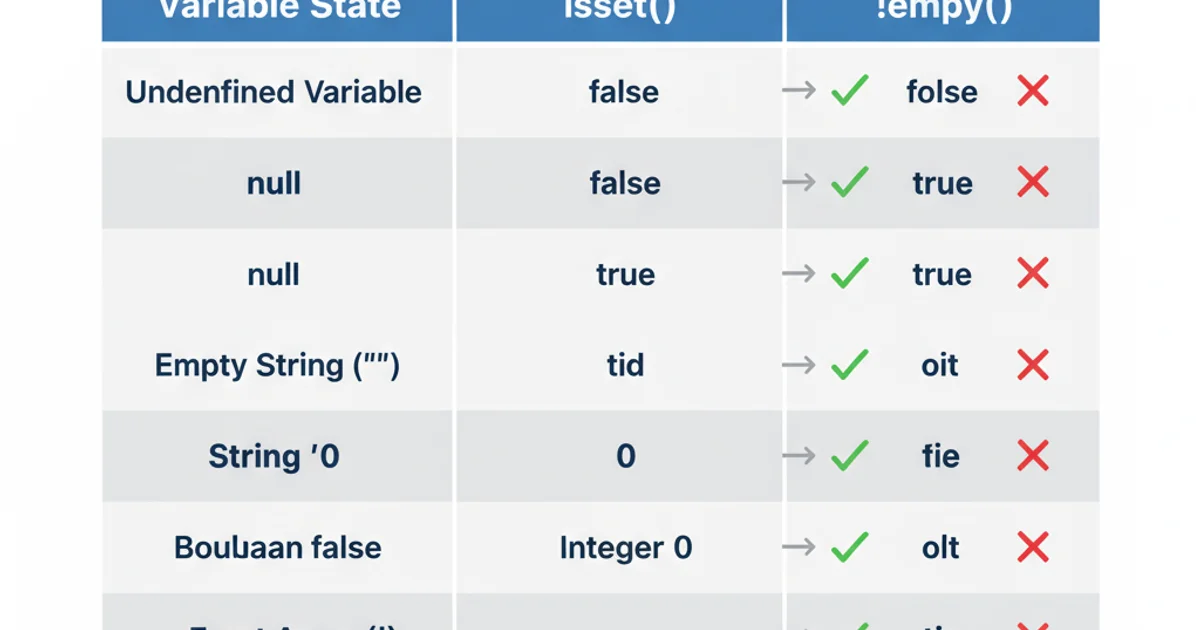What's the difference between 'isset()' and '!empty()' in PHP?
Categories:
PHP's isset() vs. !empty(): Understanding the Key Differences

Explore the fundamental differences between PHP's isset() and !empty() functions, their use cases, and how they handle various data types to prevent common errors.
In PHP development, isset() and !empty() are two frequently used language constructs for checking the state of variables. While they both deal with variable existence and value, they operate under different rules and produce different results depending on the variable's content. Understanding these distinctions is crucial for writing robust and error-free PHP code, especially when dealing with user input, array elements, or object properties.
What isset() Does
The isset() function checks if a variable is declared and is not null. It returns true if the variable exists and has a value other than null, and false otherwise. It can also check multiple variables at once, returning true only if all variables are set and not null.
<?php
$a = 0;
$b = "";
$c = null;
$d = [];
var_dump(isset($a)); // bool(true)
var_dump(isset($b)); // bool(true)
var_dump(isset($c)); // bool(false)
var_dump(isset($d)); // bool(true)
var_dump(isset($e)); // bool(false) - $e is not declared
var_dump(isset($a, $b)); // bool(true)
var_dump(isset($a, $c)); // bool(false)
?>
Examples demonstrating isset() behavior with different variable types.
isset() is particularly useful for checking if an array key or object property exists without triggering a 'Notice: Undefined index' or 'Undefined property' error. For example, isset($_GET['param']) is a common pattern.What !empty() Does
The !empty() construct checks if a variable has a non-empty and non-zero value. It returns true if the variable exists and has a 'truthy' value, and false if the variable is considered 'empty'. PHP considers the following values as 'empty':
""(an empty string)0(the integer zero)0.0(the float zero)"0"(the string zero)nullfalse[](an empty array)$var; (a variable declared without a value)
Essentially, !empty($var) is equivalent to !isset($var) || $var == false in terms of its return value for many cases, but it does not generate warnings for undefined variables.
<?php
$a = 0;
$b = "";
$c = null;
$d = [];
$e = "hello";
$f = 123;
$g = false;
var_dump(!empty($a)); // bool(false) - 0 is empty
var_dump(!empty($b)); // bool(false) - empty string is empty
var_dump(!empty($c)); // bool(false) - null is empty
var_dump(!empty($d)); // bool(false) - empty array is empty
var_dump(!empty($e)); // bool(true) - "hello" is not empty
var_dump(!empty($f)); // bool(true) - 123 is not empty
var_dump(!empty($g)); // bool(false) - false is empty
var_dump(!empty($h)); // bool(false) - $h is not declared, thus empty
?>
Examples demonstrating !empty() behavior with various variable states.
Key Differences and When to Use Each
The core distinction lies in how they treat null, 0, and empty strings. isset() only cares if a variable is declared and not null. !empty() is more concerned with the 'truthiness' of a variable's value, considering several values as 'empty' even if they are technically 'set' (like 0 or "").

Comparison of isset() vs. !empty() results across different variable types.
empty() (or !empty()) on the return value of a function that might return false or 0 as a valid result, but null or false on failure. For instance, strpos() can return 0 for a match at the beginning of a string. Using !empty(strpos(...)) would incorrectly treat a valid match at position 0 as 'empty'.Here's a quick guide on when to use each:
Use
isset()when:- You need to check if a variable, array key, or object property has been defined and is not
null. - You want to distinguish between a variable that is
nulland one that is0or an empty string. - You are checking for the presence of optional parameters (e.g.,
$_GET,$_POST).
- You need to check if a variable, array key, or object property has been defined and is not
Use
!empty()when:- You need to check if a variable contains any 'meaningful' data (i.e., not
null,0,false, or an empty string/array). - You are validating user input to ensure it's not just whitespace or a zero value when a non-zero value is expected.
- You want to ensure a string or array actually contains elements.
- You need to check if a variable contains any 'meaningful' data (i.e., not
Practical Example: Form Validation
Consider a simple form where a user enters their name and age. We want to ensure the name is provided and the age is a non-zero value.
<?php
// Simulate form submission data
$_POST = [
'username' => 'John Doe',
'age' => '0' // User entered 0 for age
];
$errors = [];
// Check if username is set and not empty
if (!isset($_POST['username']) || empty($_POST['username'])) {
$errors[] = "Username is required.";
}
// Check if age is set and is a non-empty, non-zero value
// Using !empty() here would treat '0' as invalid, which might be desired for age.
// If 0 was a valid age, you'd use isset() and then validate the value.
if (!isset($_POST['age']) || empty($_POST['age'])) {
$errors[] = "Age is required and must be a non-zero value.";
}
if (empty($errors)) {
echo "Form submitted successfully!\n";
echo "Username: " . $_POST['username'] . "\n";
echo "Age: " . $_POST['age'] . "\n";
} else {
foreach ($errors as $error) {
echo "Error: " . $error . "\n";
}
}
// Example with valid age
$_POST = [
'username' => 'Jane Doe',
'age' => '25'
];
$errors = [];
if (!isset($_POST['username']) || empty($_POST['username'])) {
$errors[] = "Username is required.";
}
if (!isset($_POST['age']) || empty($_POST['age'])) {
$errors[] = "Age is required and must be a non-zero value.";
}
if (empty($errors)) {
echo "\nForm submitted successfully!\n";
echo "Username: " . $_POST['username'] . "\n";
echo "Age: " . $_POST['age'] . "\n";
} else {
foreach ($errors as $error) {
echo "Error: " . $error . "\n";
}
}
?>
Form validation using a combination of isset() and empty().
0 or false are valid inputs, consider using strict comparison operators (=== and !==) after an isset() check, e.g., if (isset($var) && $var !== false).